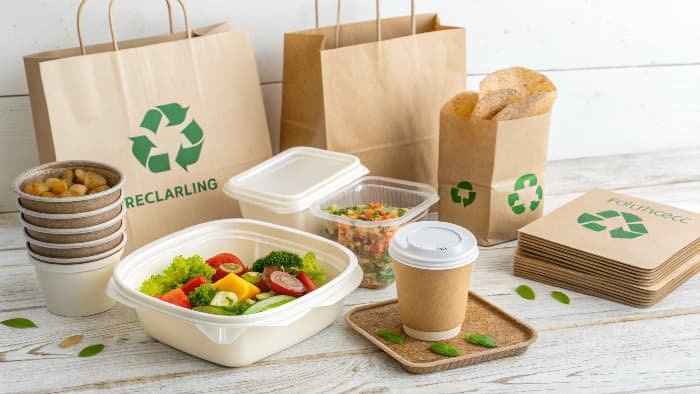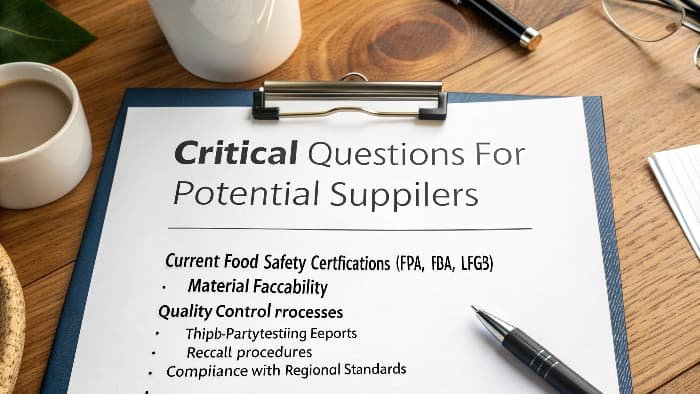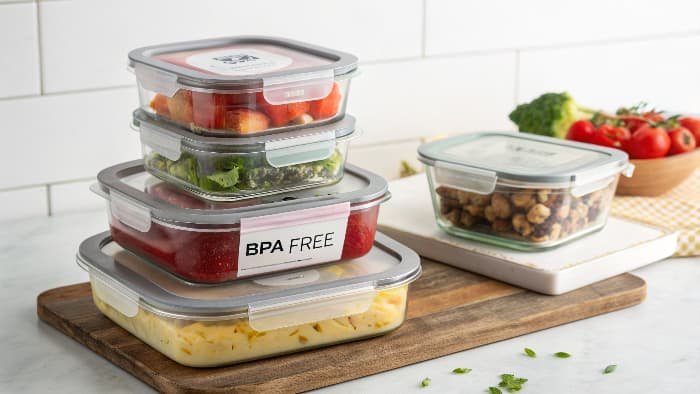Struggling to find food containers that meet safety standards? Worried about risks? We guide you to source reliably safe options, ensuring peace of mind.
To source safe food containers, prioritize materials with food-grade certifications, vet supplier compliance thoroughly, and understand specific use-case requirements. This ensures both consumer safety and regulatory adherence for your business.
Okay, so you get the basics, but there’s a lot more to unpack, right? It’s not just about ticking a box. If you’re like me, always digging deeper for my clients – people like Jacky, who need the best for his eco-conscious brand in Canada – then you know the devil is in the details. Let’s get into what really matters when you’re trying to make the right call on these containers. Stick with me, and we’ll explore how to make your sourcing process foolproof.
What Key Certifications Should I Actually Be Looking For?
Confused by all the certifications out there? Fearful of choosing incorrectly? We’ll clarify the essential certifications that genuinely ensure food container safety for your business.
Focus on FDA approval for the US market, LFGB for Europe, and look for specific material certifications like BPI for compostability or FSC for paper. These confirm adherence to safety and quality standards.
Alright, let’s talk about these certifications because, honestly, they can be a real headache if you don’t know what’s what. For someone like Jacky, who’s sourcing for a Canadian brand but might be looking at products used or even manufactured globally, this is super important. It’s not just about slapping a logo on a product; it’s about genuine safety. You know, I once had a client who almost bought a whole shipment of containers based on a cert that turned out to be for a completely different material type – yikes! Dodged a bullet there.
Key Food Safety Certifications to Prioritize:
- FDA (U.S. Food and Drug Administration): This is a big one, especially if your products touch the US market. It means the materials used are considered safe for direct food contact. We at Ecosourcecn always ensure our relevant products meet this. It’s a baseline, really. I mean, without it, you’re just asking for trouble.
- LFGB (Lebensmittel-, Bedarfsgegenstände- und Futtermittelgesetzbuch): This is the German Food and Feed Code, but it’s recognized as a high standard across Europe. If you see LFGB, it generally means the product has passed some pretty strict tests for chemical migration. Think of it as a step up in thoroughness for certain material types. It’s pretty comprehensive.
- EU Food Contact Regulations (e.g., Regulation (EC) No 1935/2004): This is the overarching framework in Europe. It sets general safety requirements, ensuring materials don’t transfer constituents to food in quantities that could endanger human health or change the food’s composition or taste. It’s good to know your supplier understands this if Europe is your market.
Beyond Basic Safety: Eco-Certifications
Jacky, with his environmental science background, also cares a lot about the eco side of things, and so do we. So, beyond basic food safety, these are also on my radar:
- BPI (Biodegradable Products Institute): If you’re looking at compostable plastics like PLA, this certification is gold. It verifies that a product will break down in an industrial composting facility. For us at Ecosourcecn, offering BPI-certified PLA utensils and containers is a core part of our sustainable solutions. This one’s a big deal for our mission.
- FSC (Forest Stewardship Council): For paper products – think kraft paper containers or cups – FSC certification ensures the paper comes from responsibly managed forests. This aligns perfectly with our slogan: "Sustainable Solutions, Global Impact." It feels good to support this.
It’s not just about having the certs; it’s about understanding which ones matter for your specific product and market. I always tell my clients, ask for the documentation, don’t just take a supplier’s word for it. It’s your reputation on the line, too! We’ve had experiences where a supplier claimed a certification, but a little digging showed it was expired or for a different material. So, yeah, due diligence is key. This is something we drill into our team here at Ecosourcecn when we vet our own manufacturing partners. It’s serious business.How Do Material Choices Seriously Impact Food Safety and Our Planet?
Overwhelmed by material options? Concerned about safety and eco-impact? We break down how different materials affect food safety and sustainability, guiding your choice.
Choose food-grade plastics like PP (polypropylene) for microwaves, PET for clarity, or PLA for compostability. Bagasse and kraft paper are great eco-friendly options. Each material has specific safety profiles and environmental footprints.

Okay, so we’ve talked certs. Now, let’s get into the nitty-gritty of materials. This is where Jacky, with his packaging engineering insights, really shines, but it’s crucial for any buyer. The material isn’t just about looks or cost; it’s fundamental to safety and, for us at Ecosourcecn, sustainability. You wouldn’t believe how many times I’ve seen people choose a material just because it’s cheap, without thinking about how it reacts with food or its end-of-life. Big mistake! I remember a local café owner who bought cheap containers, and then customers started complaining their hot food tasted weird – turns out the plastic was leaching. Not good for business, or health!
Common Materials and Their Food Safety Angles:
| Material | Common Uses | Food Safety Considerations | Sustainability Notes |
|---|---|---|---|
| PP (Polypropylene) | Take-out containers, microwaveable | Generally safe, good heat resistance. Look for "microwave-safe" labels. Avoid BPA. | Recyclable (check local facilities), not biodegradable. |
| PET/PETE (Polyethylene Terephthalate) | Drink bottles, clear food containers | Good barrier properties, clear. Generally safe. Not ideal for hot foods unless specified. | Widely recycled, but still plastic. |
| PLA (Polylactic Acid) | Compostable cutlery, cold cups, containers | Made from renewable resources (corn starch, sugarcane). Food safe. Best for cold/room temp. | Commercially compostable (BPI certified). Huge win! |
| Bagasse (Sugarcane Pulp) | Plates, bowls, clamshells | Natural byproduct, sturdy, microwaveable, freezable. Food safe. | Biodegradable and compostable. Excellent eco-choice. |
| Kraft Paper | Bags, boxes, some containers | Often lined with PLA or PE for grease/moisture resistance. Ensure lining is food-grade. | Renewable, often recyclable/compostable (if unlined). |
| PS (Polystyrene) | Foam containers (avoid!), some lids | Potential for styrene leaching, especially with hot/acidic foods. Many areas banning it. | Difficult to recycle, bad for environment. We avoid. |
When I’m advising someone like Jacky, we dive deep into the specific application. Is it for hot soup? Then maybe PP or bagasse. Is it a salad going into a cold display? PLA or PET could work. The key is understanding the interaction. For example, some acidic foods can react poorly with certain plastics if they aren’t properly rated. And let’s be real, no one wants their customer’s food tasting like plastic, or worse, ingesting harmful chemicals. That’s why at Ecosourcecn, we’re super transparent about what our products are made of and what they’re suitable for. We push for PLA, bagasse, and FSC-certified paper because they align with our "Sustainable Solutions, Global Impact" mission. It’s not just about avoiding the bad stuff; it’s about actively choosing the good stuff – for people and the planet. That’s how we help our partners transition to a greener future. It’s a journey, for sure, but a worthwhile one. I think you can really feel good about making these choices.
What Critical Questions Must I Ask My Potential Suppliers?
Worried about unreliable suppliers? Unsure what to ask to ensure safety? We list critical questions to vet suppliers effectively, protecting your business and customers.
Ask for current food safety certifications (FDA, LFGB), material traceability, quality control processes, and third-party testing reports. Inquire about their recall procedures and compliance with specific regional standards.

So, you’ve got your ideal material in mind, you know which certifications you need – awesome! But now comes a really crucial part: talking to suppliers. You can’t just assume everyone’s on the level. I’ve learned this the hard way over the years. As an export partner, Ecosourcecn has built its reputation on trust and transparency, and that starts with how we vet our sources, and how we advise our clients, like Jacky, to vet theirs. It’s not about being difficult; it’s about being thorough. It’s like, you wouldn’t buy a car without looking under the hood and asking about its service history, right? Same principle.
Essential Questions for Your Supplier Checklist:
- "Can you provide current copies of all relevant food safety certifications (e.g., FDA, LFGB, specific EU regulations) for this exact product?"
- Why it matters: "Relevant" and "current" are key. A cert for a different product or an expired one is useless. We always ask for the PDF and check the dates and product scope. I mean, it sounds basic, but you’d be surprised.
- "What is your process for ensuring material traceability?"
- Why it matters: You need to know where the raw materials come from. Can they trace a batch back to its origin if there’s an issue? This is huge for quality control. If they can’t answer this, hmm, that’s a bit of a worry.
- "Can you describe your in-house quality control procedures during manufacturing?"
- Why it matters: What checks do they perform? How often? Do they test for contaminants or defects? A good supplier will have a robust QC system. We’ve seen factories where QC is just a guy at the end of the line glancing at things – not good enough!
- "Do you conduct third-party testing, and can you share recent reports?"
- Why it matters: Independent verification is always better. It shows they’re confident in their product meeting standards. For Ecosourcecn, this is a non-negotiable for many of our product lines. It just adds that extra layer of trust.
- "What is your recall procedure if a safety issue is discovered post-shipment?"
- Why it matters: Things can go wrong. A responsible supplier will have a plan. How will they notify you? How will they handle returns or replacements? This protects your business. Seriously, you need to know this before there’s a problem.
- "Are you familiar with and compliant with [specific regional/country] regulations that apply to my market?"
- Why it matters: Jacky in Canada might have slightly different nuances than a client in Europe. The supplier needs to understand and cater to this. If they look blank, that’s a red flag. 🚩
- "Can you accommodate private label requirements while maintaining all safety and compliance standards?" (This one’s key for clients like Jacky)
- Why it matters: Customization shouldn’t compromise safety. We do a lot of private label work, and ensuring the integrity of the product through that process is paramount. It’s your brand on there, after all!
Asking these questions isn’t just a formality. It’s about building a partnership. A good supplier will welcome these questions and have ready answers. If they’re evasive or annoyed, well, that tells you something too, doesn’t it? I always tell people, trust your gut, but verify with facts! It’s how we operate at Ecosourcecn, delivering practical, scalable green solutions.Beyond Compliance, What Truly Makes a Food Container ‘Safe’ and ‘Good’ for Today’s Consumer?
Is mere compliance enough? Wondering about broader safety and consumer trust? We explore factors beyond rules that define truly safe and appealing food containers.
Truly ‘safe’ means no harmful chemical leaching, physical integrity (no breaks/leaks), suitability for intended food/temperature, and clear labeling. ‘Good’ also implies ethical sourcing and minimal environmental impact.
- Why it matters: Customization shouldn’t compromise safety. We do a lot of private label work, and ensuring the integrity of the product through that process is paramount. It’s your brand on there, after all!

Alright, we’ve covered the technical stuff – certs, materials, supplier questions. These are the backbone of sourcing safe food containers. But I think, and I know Jacky with his eco-conscious brand would agree, that "safe" and "good" go beyond just meeting the minimum legal requirements. It’s about the bigger picture, especially in today’s market where consumers are so much more aware. At Ecosourcecn, our mission to reduce global plastic waste touches on this broader definition. It’s not just about what’s not bad, but what’s actively good.
Elements of a ‘Truly Safe and Good’ Food Container:
- Absence of Harmful Leachables (Beyond the Basics):
- Sure, a container might pass FDA, but are there concerns about things like PFAS (the "forever chemicals") in some paper-based items if not sourced carefully? Or BPA/BPS/BPF in plastics, even if levels are "compliant"? A truly good container aims for the cleanest possible material composition. We are always researching and pushing our suppliers for alternatives that go above and beyond. It’s a constant evolution – and honestly, a bit of a passion for us.
- Physical Integrity and Functionality:
- A container isn’t safe if it cracks easily, leaks hot soup onto someone, or has sharp edges from poor manufacturing. So, "safe" also means robust and fit for purpose. I remember a client who switched to a cheaper supplier and suddenly had complaints about lids popping off during delivery – that’s a safety and quality fail! That kind of thing can really damage a brand.
- Suitability for Intended Use (and Clear Communication):
- Is it really microwave-safe, or just "won’t melt immediately"? Is it freezer-safe without becoming brittle? Clear labeling and honest communication about a container’s limits are vital. We try to be super clear with our product specs for things like our PLA utensils (cold use primarily) versus our bagasse containers (hot and cold). No nasty surprises for the end user!
- Ethical Sourcing and Manufacturing:
- This is a big one for us. Were the workers who made it treated fairly? Are the raw materials sourced responsibly (like our FSC-certified paper)? Consumers increasingly care about the ethics behind the products they use. It’s part of that "global impact" in our slogan. It just feels right, you know?
- Minimal Environmental Impact (The Ecosourcecn Sweet Spot):
- This is where we live and breathe. Is it made from renewable resources? Is it biodegradable or compostable? Is it easily recyclable? For Jacky’s brand, and for many of our clients, this isn’t a "nice-to-have," it’s a must-have. It’s about offering sustainable alternatives like PLA, bagasse, and compostable bags that genuinely help our partners (and their customers) move towards a greener future. This is the stuff that gets us excited! 🔥
- Transparency and Trust:
- Ultimately, a "good" container comes from a supplier you trust, one who is transparent about their processes and products. This builds confidence not just for you as the buyer, but for the end consumer. It’s about that solid handshake feeling.
So, you see, it’s a holistic view. It’s not just about a checklist of regulations. It’s about a commitment to quality, safety, ethics, and sustainability. That’s the standard we aim for at Ecosourcecn. It’s a journey, and sometimes it means asking the tough questions or making the harder choices, but it’s worth it. When you help a client like Jacky find that perfect, safe, and sustainable solution, it’s a great feeling.Conclusion
Sourcing safe containers means checking certs, choosing right materials, vetting suppliers, and thinking beyond basic compliance. It’s about true safety and sustainability for everyone.
- Ultimately, a "good" container comes from a supplier you trust, one who is transparent about their processes and products. This builds confidence not just for you as the buyer, but for the end consumer. It’s about that solid handshake feeling.


